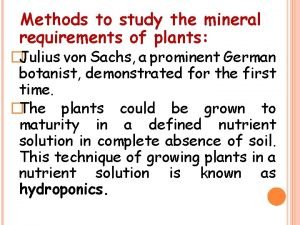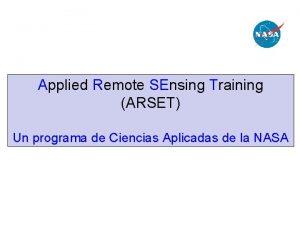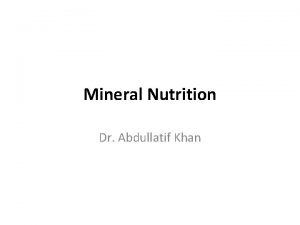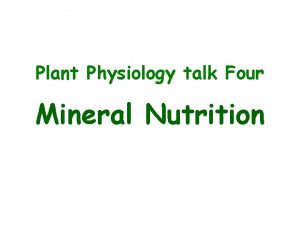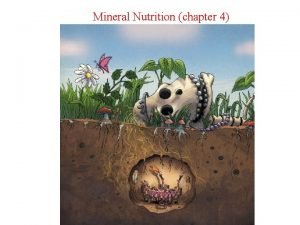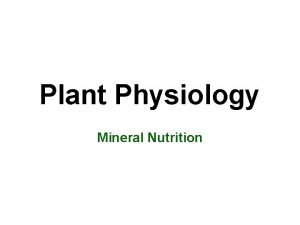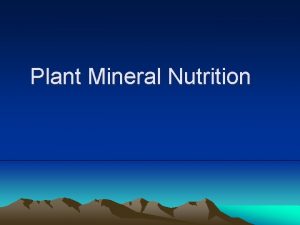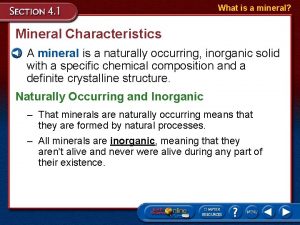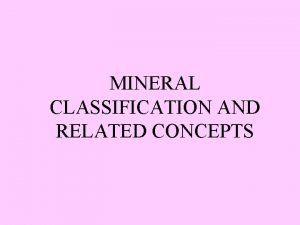Mineral Nutrition Mineral Nutrition In remote Past it



















- Slides: 19

Mineral Nutrition

Mineral Nutrition • In remote Past, it was realized that land plant obtain nourishments from soil. • During 1 st half 19 th century, Plants grow and develop in the presence of certain chemical elements---Essential elements • These elements are taken by plants as inorganic ions • Source of inorganic ions in soil----Minerals

Definition • Mineral nutrition was suggested to refer to an inorganic ion obtained from soil and required for plant growth

Essential elements • 16 • Required for plant growth and maintenance • Their absence develop in plants deficiency symptoms due to nutrition disorder • Criteria • Plants cannot complete its life cycle i. e. not form viable seeds • It forms any part of molecules or constituent of the plant that is itself essential in plant e. g. N in proteins and Mg in chlorophyll

Macronutrients • • • C, H, O N, P, K, S, Mg, Ca Microelements Zn, Fe, Cu, Mn, Mo, B, Cl Beneficial elements Na (Salt-marsh plants C 4 Pathway ), Si (Grasses), Co (Wheat, and legume species), Se (Saline soil plants), Ni (Essential compnent for enzymes)

Role and Deficiency Symptoms of Macronutrients

Carbon, Hydrogen and Oxygen (C, H and O): • These are the non-mineral essential elements commonly enter a plant body as CO 2, H 2 O. • These elements are the building blocks of macromolecules and constitute over 90% of the total dry matter of the plant. • Hence these are commonly known as framework elements.

Nitrogen Role • Nitrogen is essential for Amino acid formation. • Necessary for cell division and for plant growth. • Necessary part in Photosynthesis formation. • Essential formation and uses of carbohydrates. • Affects the anabolic and catabolic reactions in plants.

Deficiency Symptoms • Lower leaves show chlorosis (lack of chlorophyll) • Necrosis in older leaves. • Reduction in quality. • Crop mature early but of poor quality. • Yellow discoloration of leaf tips.

Role of phosphorous • It is a constituent of phospholipids (membrane lipids), nucleic acids, nucleotides, coenzymes, ATP, metabolic intermediates, sugar phosphates in photosynthesis etc.

Symptoms of phosphorus in plants • (i) Purple or red pigmentation on leaves, Older leaves affected first and become dark brown • (ii) Premature fall of leaves and floral buds • (iii) Delay in seed germination • (iv) Stunted and slender stem in young plants, • (v) Accumulation of carbohydrates in Glycine max (Soybean), • (vi) Vascular tissues reduce in tomato plants.

Role of Potassium in plants • (i) Essential for stomatal opening, translocation of sugar, protein synthesis, activation of enzymes and maintenance of cell turgor. • (ii) Determine anion-cation balance in cell.

Symptoms of deficiency potassium in plants • (i) Chlorosis followed by necrosis of leaf tips, margins and between veins • (ii) Loss of apical dominance, leads to rosette or bushy habit • (iii) Loss of cambial activity • (iv) Disintegration of plastids • (v) Rate of respiration increases • (vi) Dieback of shoots i. e. progressive death from shoot tip towards base

Role of calcium in plants • (i) Used in synthesis of calcium pactate in middle lamella of cell wall • (ii) Involved in normal functioning of cell membrane • (iii) Used in formation of mitotic spindle • (vi) Activates certain enzymes like ATPase, kinases and succinate dehydrogenase.

Symptoms of calcium in plants • (i) Stunted growth • (ii) Chlorosis, and deformation in young leaves, • (iii) Necrosis of young meristematic regions such as root tips or young leaves.

Role of magnesium in plants • (i) Important constituent of chlorophyll • (ii) Maintains ribosome structure and chromatin fibre • (iii) Activates enzymes in respiration, photosynthesis and synthesis of DNA and RNA.

Symptom of magnesium deficiency in plants • (i) Chlorosis between the leaf veins • (ii) Necrotic or purple spots on older leaves. • (iii) Extensive development of chlorenchyma and scanty pith formation. • (iv)Reduced photosynthetic activity. • (v)Reduction in enzyme activity.

Role of Sulphur in plants • • Essential element of Amino acid. Help in formation of enzymes and vitamins. Essential for seed formation. Play important role in chlorophyll formation.

Symptoms of Sulphur deficiency in plants • Reduction in protein and chlorophyll synthesis. • Young leaves become yellow from green colour, If not protected all plant become pale green. • Stem become short. • Stunted growth of plant.
 Mineral nutrition in plants ppt
Mineral nutrition in plants ppt Mineral nutrition in plants ppt
Mineral nutrition in plants ppt Past simple past continuous past perfect
Past simple past continuous past perfect Past simple past continuous past perfect simple
Past simple past continuous past perfect simple Simple past and progressive
Simple past and progressive Llll progressive form
Llll progressive form Narrative tenses konu anlatımı
Narrative tenses konu anlatımı Past perfect and past progressive
Past perfect and past progressive Narrative tenses past simple
Narrative tenses past simple Past simple past continuous present perfect exercises
Past simple past continuous present perfect exercises Exercise past simple past continuous and past perfect
Exercise past simple past continuous and past perfect Past continuos
Past continuos Remote sensing in precision agriculture
Remote sensing in precision agriculture Electron 12 remote
Electron 12 remote Strip camera in remote sensing
Strip camera in remote sensing Dr terence palmer
Dr terence palmer Remote connection or sniffer detected
Remote connection or sniffer detected Applied remote sensing training program
Applied remote sensing training program Remote sensing applications center
Remote sensing applications center Remote procedure call architecture
Remote procedure call architecture

